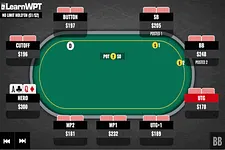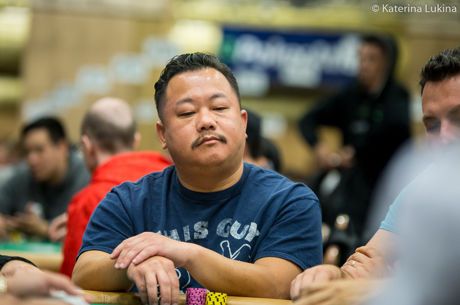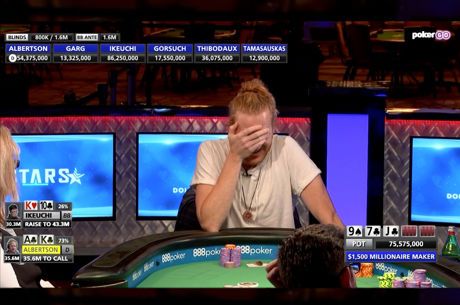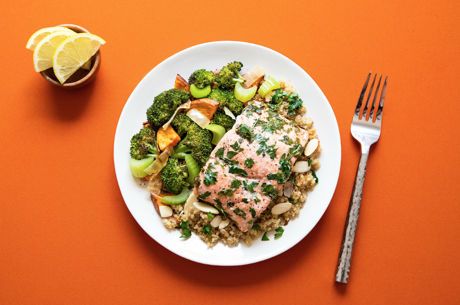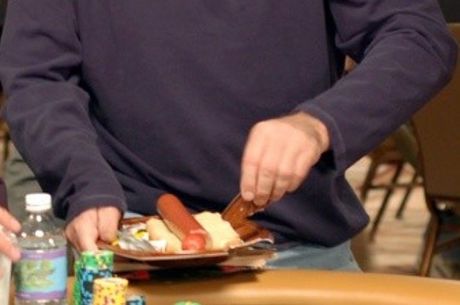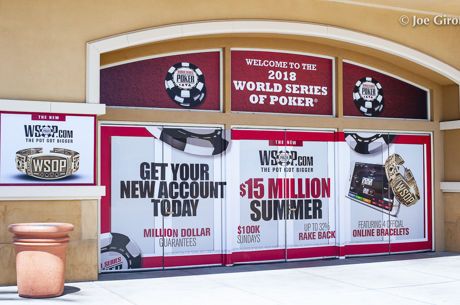The Deal With Dominik: Tackling Heads-Up Strategy

Heads-up may be the poker variant most rounders play the least — whether to end a final table or in a cash game. Dueling it out mano a mano with another player comes with some different nuances, challenges, and strategies.
With the $10,000 Heads-up No Limit Hold'em Championship ongoing at the 2018 World Series of Poker, PokerNews sat down with 888poker Ambassador Dominik Nitsche to get strategy advice for all those looking for some improvement in their heads-up games. We spoke with Nitsche just after he had won his first-round matchup and was waiting for Round 2.
Originally from Germany, but now living in London, Nitsche has a massive amount of experience at the tables with numerous titles and final table appearances, four WSOP bracelets, and over $14.6 million in tournament winnings. That includes earning almost $6.5 million at the WSOP, enough to be ranked 24th in all-time cash winnings.
Nitsche eats, sleeps, and breathes poker. Studying and analyzing hands is a constant part of his playing routine. That includes playing heads-up regularly online and then analyzing the hands that stood out.
Heads-Up Primer
When it comes to heads-up play, players will need to play more hands to a degree but must guard against getting too out of line. Playing too many poor hands can lead to unnecessarily large pots and being on the short end of those.
"Remember that everyone knows you've got to play more hands," he says. "But just because it's only two players, that doesn't mean you have to just go crazy. It's still the same game. Some people just lose their mind trying to make ridiculous bluffs and ridiculous calls just because there are only two people at the table."
People just consistently overplay their medium hands because they think, "It's heads up, I can't fold."
For many players, there's a general problem of over-adjusting their games in heads-up play, altering their normal strategy too greatly because they face just a single opponent.
"People bluff with too many hands" in heads-up, he says. "People just consistently overplay their medium hands because they think, 'It's heads up, I can't fold, I can't do this.'"
While a player may need to play more hands, Nitsche says there is a limit and it's still the same game and players need to play smart. He said players may need to loosen up their games, but should continue to stay disciplined.

"Obviously, people just tend to overvalue their hands heads-up," he says. "People just think, 'I like this hand heads-up.' Well this is all well and good, but you know it doesn't mean that your opponent can't have a good hand as well."
"A lot of it is just realizing how to evaluate your hand heads-up against your opponent with a wide range, and that's a very hard skill to have as well."
When it comes to starting hands, Nitsche says to be more aggressive when in position preflop. Players should be raising the button quite frequently, probably in the neighborhood of 85 to 90 percent of hands, while still maintaining that discipline and being willing to fold.
"It's a good adjustment," he says. "If your opponent is a bit on the more passive side, you would go over 85 percent of hands for a raise. And if your opponent is very passive, you can certainly go to 100 percent."
When a player hits a pair on the board, even second or third pair, Nitsche says those hands can be powerful in heads-up. It's important to protect those small pairs with a bet much more frequently because opponents are much more likely to call with just ace-high.
"Certainly more than in traditional full ring no-limit hold'em where a lot of people will choose to check behind the middle pair, in heads-up oftentimes it's a bet for one street on the flop and then you look to check the turn and call a bluff on the river," he says. "You've just got to keep in mind what your opponent is worth sometimes, so you do need certain bluff catchers.
"When you have a small pair you want to try and get them to showdown and do that by checking behind, betting the flop, then checking behind. Basically try to think that you need some hands to get to showdown. You cannot always just go to showdown with just top pair because otherwise you'll be playing too weak."
By the same token, Nitsche says you can't take just any pair to showdown at any time, either. Players must find the right balance and get a read on their opponents and range of hands.
Study Time
Studying is a big part of Nitsche's improvement and something he recommends for those hoping to play at a high level. How does he work on his heads-up play? There are programs that teach how to play correct heads-up poker, and he makes use of those in his preparation.
"You don't really get much better just by playing. You get better by studying off the tables."
"There are programs out there that can teach you a preflop strategy," he says. "And then when you have the pre-flop strategy down, you can just run a bunch of calculations. Figure out how to play your range against their range, which bet-sizing to use, and that's pretty much all I've been doing to get better heads-up."
Nitsche goes through all these heads-up strategies and studies regularly. His routine:
- Play in a heads-up session online for an hour or two online.
- Try to get as many hands in as possible.
- Review the most interesting hands post-session.
"I write them all down and ask myself questions about the hand," he says. "Afterward I go through them and that's probably the best way to improve."
For Nitsche, reviewing hands after playing either online or live is a big part of his poker routine. Playing and studying go hand-in-hand and he spends two to three hours a day just in study mode.
"I don't really feel like just playing, and then not looking at the hands I've just played," he says. "That would just be boring for me and I basically just play heads-up cash to enjoy the game and get better. You don't really get much better just by playing. You get better by studying off the tables."
Sean Chaffin is a freelance writer in Crandall, Texas. His work appears in numerous websites and publications. Follow him on Twitter @PokerTraditions. He is also the host of the True Gambling Stories podcast, available on iTunes, Google Play, TuneIn Radio, Spotify, Stitcher, PokerNews.com, HoldemRadio.com, and TrueGamblingStories.com.


